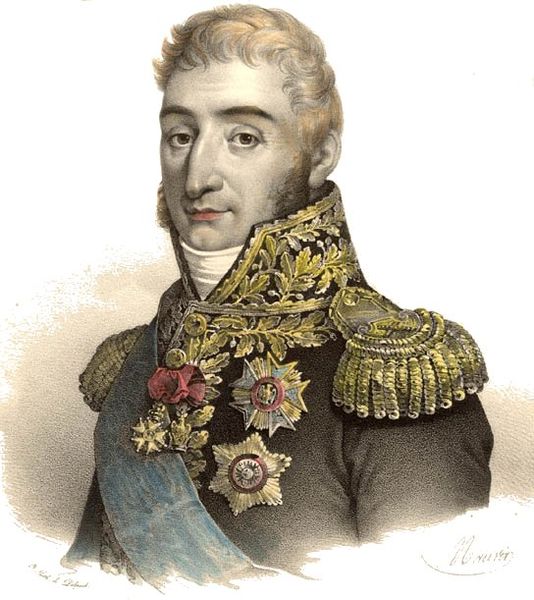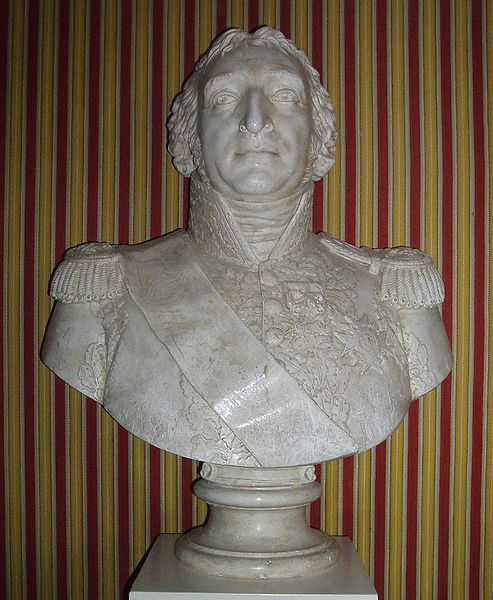<Back to Index>
- Economist James Denham Steuart, 1712
- Painter Jan Altink, 1885
- Marshal of France Charles Pierre Francois Augereau, 1st Duc de Castiglione, 1757
PAGE SPONSOR


Charles Pierre François Augereau, 1st Duc de Castiglione (21 October 1757 – 12 June 1816) was a soldier and general and Marshal of France. After wandering across Europe for years, he returned to his native France to fight in the French Revolutionary Wars. He earned rapid promotion while fighting against Spain and soon found himself a division commander under Napoleon Bonaparte in Italy. He fought in all of Bonaparte's battles of 1796 with great distinction. During the Napoleonic Wars, Emperor Napoleon entrusted him with important commands. His life ended under a cloud because of his poor timing in switching sides between Napoleon and King Louis XVIII of France.
Pierre Augereau was born in Faubourg Saint-Marceau, Paris, as the son of a Parisian fruit seller (in some accounts, a servant). He enlisted in the army at the age of seventeen in the Clare Infantry Regiment, but was soon discharged. Later he joined the dragoons. He became a noted swordsman and duellist, but he had to flee France after killing an officer in a quarrel. For the next 13 years he drifted across Europe. He claimed to have served in the Russian army against the Ottoman Empire, afterwards deserting. He enlisted in the infantry regiment of Prince Henry of Prussia and said he served in the Prussian Foot Guards as well. He deserted by masterminding a mass escape and reached the border of Saxony where he taught fencing.
In 1781, King Louis XVI of France proclaimed an amnesty for deserters, so Augereau returned to his native land. He joined the cavalry in 1784, and after serving in the carabiniers he was sent to the Kingdom of Naples as part of a military mission. While in Naples, he eloped with Gabrielle Grach and the two lovers traveled to Portugal where they spent the years 1788 – 1791. After the French Revolution broke out, the Portuguese jailed Augereau as a dangerous foreigner. Somehow Gabrielle persuaded the authorities to release her husband and the couple returned to France. In September 1792, Augereau joined a volunteer cavalry unit, the German Legion. But this is without proof as Augereau claims that the papers were taken away from him during the Portugese Inquisition.
Augereau's unit was sent to put down the Revolt in the Vendée in April 1793. The German Legion proved useless in battle because many of the soldiers switched sides, and the officers, including Augereau and François Marceau found themselves in prison. Released, he served briefly in the 11th Hussars before serving as wagonmaster and as aide de camp to General Jean Antoine Rossignol. He was assigned to train recruits for General Jean Antoine Marbot at Toulouse. Marbot liked his work and the Marbot family became Augereau's close friends.
It is not clear when, or if, Augereau received promotion to general of brigade, but he transferred to the Army of the Eastern Pyrenees, and was promoted to general of division on 23 December 1793. When Jacques François Dugommier became commander in January 1794, the army was thoroughly reorganized. Augereau became a division commander and played a significant role at the Battle of Boulou from 29 April to 1 May, where his feint attacks lured Luis Firmin de la Union's Spanish army into a false position. After the victory at Boulou, the army advanced a short distance into Spain, with Augereau holding the right wing. At the Battle of San Lorenzo de la Muga on 13 August, he skilfully repelled the assaults of 20,000 Spaniards with his 10,000 French troops. On 17 November, Dugommier launched a major offensive against the Spanish at the Battle of the Black Mountain. On the first day, Augereau's attack crushed the Spanish left flank while other French attacks proved unsuccessful. Dugommier was killed on the second day, but after a day's pause, the advance resumed and the Spanish were routed.
After the Peace of Basel ended the War of the Pyrenees in July 1795, Augereau and his division transferred to the Army of Italy. On 23 November 1795, Augereau fought at the Battle of Loano against the Austrian Habsburgs and Piedmontese. During the fighting, his troops attacked on the right near the coast, while André Masséna's division pierced the Allied center. The following April, his close association with Napoleon Bonaparte began when Bonaparte took command of the army and launched the Montenotte Campaign. Augereau fought the Battle of Millesimo on 13 April 1796, and accepted the surrender of the castle of Cosseria the next morning. He led his troops at the Battle of Ceva on the 16th. He served in the Lodi campaign in early May and fought at the Battle of Borghetto on 30 May.
But it was at the Battle of Castiglione on 5 August 1796 that Augereau rendered the most signal services. Jean - Baptiste - Antoine - Marcelin, Baron de Marbot described him as encouraging even Bonaparte himself in the confused situation that prevailed before that battle, though Marbot's memoirs are hardly the most reliable source. In any case it was Bonaparte's undoubted superiority as a strategist that made the victory at Castiglione a possibility. On 3 August, while Bonaparte defeated the Austrian corps of Peter Quasdanovich, Augereau held off the main Austrian army of Dagobert Sigmund von Wurmser. With 11,000 men, he attacked Anton Lipthay's brigade and drove it back on the Austrian main body. By the end of the day, Augereau faced 20,000 Austrians. The fighting cost the Austrians about 1,000 casualties, while French losses were also heavy and included General of Brigade Martial Beyrand killed. Augereau's bold front allowed Bonaparte to dispose of Quasdanovich, then mass his main strength to beat Wurmser at Castiglione two days later.
Shortly after Castiglione, Bonaparte tersely summed up Augereau's military qualities: "Much character, courage, steadiness, activity; is used to war, liked by the soldiers, lucky in his operations."
In 1797 Bonaparte sent Augereau to Paris to encourage the Jacobin Directors. Augereau and the troops led by him coerced the "moderates" in the councils and carried through the coup d'état of 18 Fructidor (4 September 1797). He was then sent to command French forces in Germany.
Augereau took little part in the coup d'état of Brumaire (November
1799), and did not distinguish himself in the Rhenish campaign which
ensued. Nevertheless, owing to his final adhesion to Bonaparte's
fortunes, he received a Marshal's baton at the beginning of the First French Empire on 19 May 1804. Augereau commanded a camp in Brest, Brittany, during the preparations for the invasion of England.
When Napoleon called off the invasion because of the growing threat
from Austria and Russia, the camp became the VII Corps of the Grande Armée. With this force, Augereau fought in the War of the Third Coalition. His corps was charged with protecting the army’s lines of communications during the Ulm Campaign. He fought actions at Konstanz and Bregenz, and he tracked down and destroyed Franz Jellacic's Austrian division at Dornbirn in the Voralberg on 13 November 1805. This was followed by the occupation of Frankfurt am Main. His wife Gabrielle died while he was away. In the War of the Fourth Coalition he was again at the head of the VII Corps. He distinguished himself at the Battle of Jena on 14 October 1806 where his corps made up the left flank. Early in 1807 he fell ill with fever, and at the Battle of Eylau on
7 February 1807, he had to be supported on his horse. Nevertheless, he
directed the movements of his corps with his usual bravery. His corps
was almost annihilated and the marshal himself received a wound in the
arm from grapeshot. He became Duke of Castiglione on 19 March 1808, a hereditary victory title (i.e.
not in chief of an actual fief, but a hollow title), in honour of the
1796 victory. This title granted his heirs ducal rank till its
extinction in 1915. In 1809 he married the 19 year old
Adélaïde Josephine Bourlon de Chavange (1789 – 1869) whom
he had become infatuated with. Adélaïde,
the daughter of Gilles Bernard Bourlon de Chavange and wife Jeanne
Françoise Launuy, had no children with Augereau, but his nephews
became heirs of the ducal title. His wife later remarried Camille de
Sainte - Aldegonde (1787 – 1853), by whom she had a daughter Valentine de
Sainte - Aldegonde (1820 – 1891), who married the 3rd Duke of Dino. When transferred to Catalonia,
where he commanded from February to May 1810, Augereau gained some
successes but tarnished his name by cruelty. In the campaign of 1812 he
guarded the rear areas. He sat out the spring 1813 campaign because of illness. Before the Battle of Leipzig (October
1813), Napoleon reproached him with not being the Augereau of
Castiglione; to which he replied, "Give me back the old soldiers of
Italy, and I will show you that I am." Yet he led the IX Corps at Leipzig with skill and brought off his command in good order. In 1814 Augereau had command of the army of Lyon, and his slackness exposed him to the charge of having come to an understanding with the Austrian invaders. Thereafter he served the restored Bourbon King Louis XVIII of France. But, after reviling Napoleon, he went over to him during the Hundred Days. The Emperor repulsed him and charged him with being a traitor to France in 1814. Louis
XVIII, when re-restored to the royal throne, deprived him of his
military title and pension. Augereau died at his estate of La Houssaye. He is buried in the Père Lachaise Cemetery.